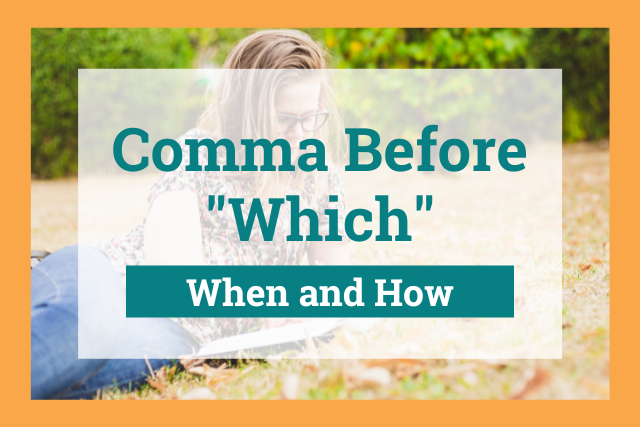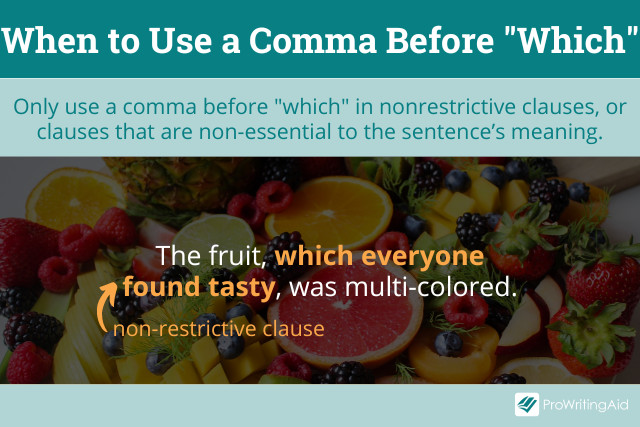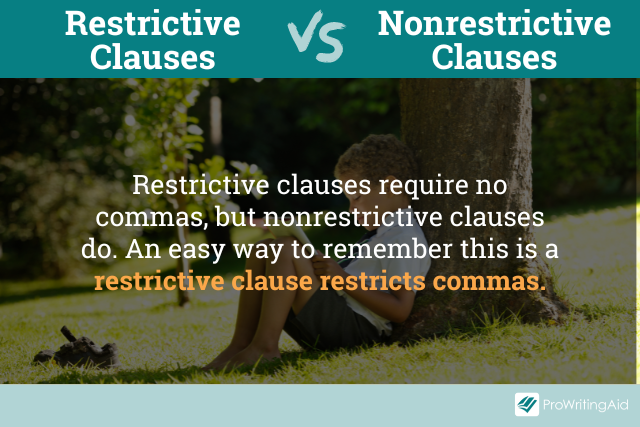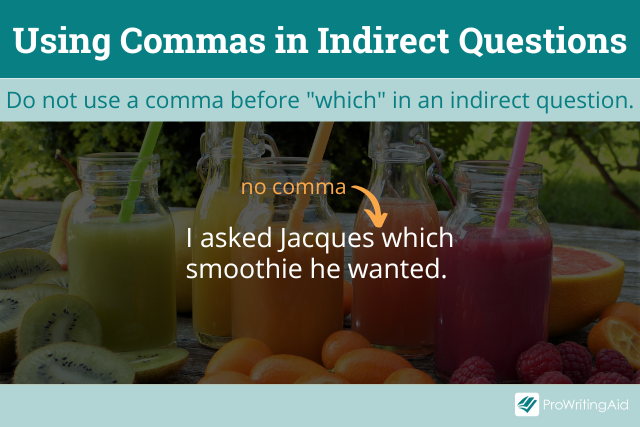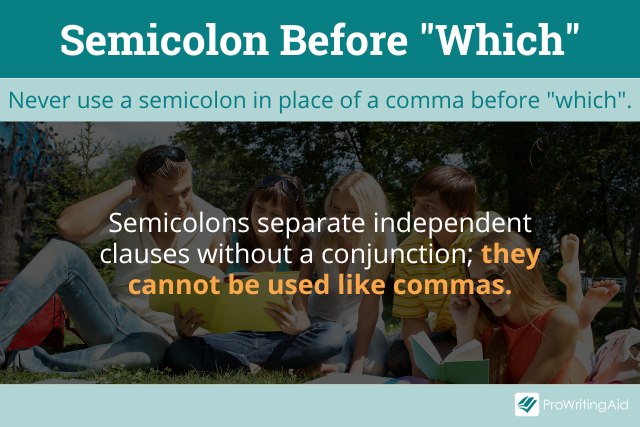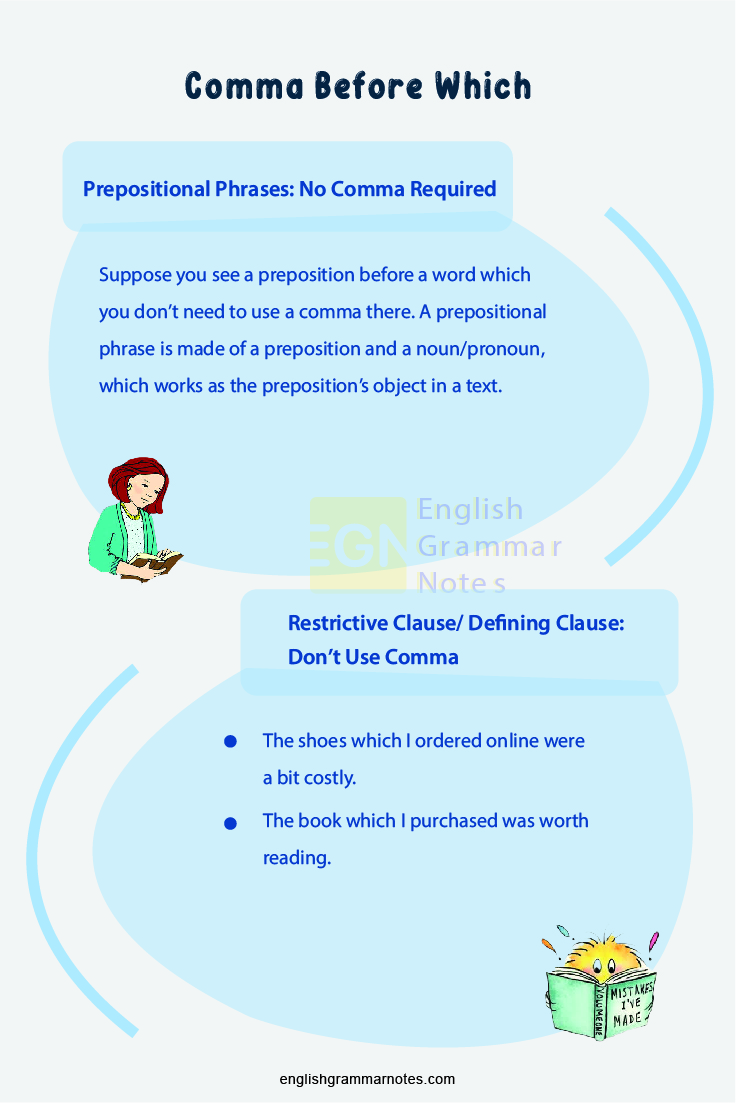Comma rules are confusing because they change depending on the situation. You might be unsure whether to use a comma before which since the answer is different depending on the sentence.
In general, the rule is to only use a comma before which when which is part of a non-restrictive clause.
You can always double-check your comma usage with our free grammar checker. But let’s take a closer look at the rules about commas before which, so you can avoid making a mistake in the first place.
Do You Put a Comma Before Which?
There are three main situations when you might use which in a sentence:
- In dependent clauses
- In questions
- In prepositional phrases
We’ll discuss each of these usages and whether to use a comma before which in them.
Comma Before Which in Non-Restrictive Clauses
A dependent clause can be classified as either a restrictive clause or a non-restrictive clause. To know when to use a comma before which, you need to understand the difference between these two types of clauses.
A restrictive clause is also called a defining clause. These clauses add crucial information to a sentence. If you remove a restrictive or defining clause, you change the sentence’s meaning.
For restrictive clauses, do not use a comma before which or after the clause. Here’s an example:
Correct: The house which we toured on Saturday sold above the asking price.
Incorrect: The house, which we toured on Saturday, sold above the asking price.
Incorrect: The house, which we toured on Saturday sold above the asking price
Incorrect: The house which we toured on Saturday, sold above the asking price.
The “which clause” is essential to the sentence. Without it, we don’t know which house we’re talking about. That makes it restrictive.
However, we use a comma before which in non-restrictive clauses. A non-restrictive clause adds non-essential information to a sentence. The meaning of the sentence stays the same if we remove a non-restrictive, or non-essential, clause.
You should also place a comma after non-restrictive clauses. Think of the commas as bookends marking the part of the sentence that contains non-essential information. Let’s check out some examples.
Correct: Making the fruit salad, which everyone found tasty, was my best idea.
Incorrect: Making the fruit salad which everyone found tasty was my best idea.
Incorrect: Making the fruit salad, which everyone found tasty was my best idea.
Incorrect: Making the fruit salad which everyone found tasty, was my best idea.
If the “which clause” is non-restrictive and falls at the end of a sentence, place a comma before which, then end the sentence with the appropriate ending punctuation. It should look like this:
Correct: I brought fruit, which was my best idea.
Remember: restrictive clauses don’t require commas but non-restrictive clauses do. An easy way to remember this is by noting that a restrictive clause restricts commas.
Comma Before Which in Questions
Sometimes people erroneously put a comma before which in questions. There is no need to use a comma before which in any question.
Direct questions might start with which (e.g. Which one do you want?). Obviously, these don’t need a comma before the sentence begins.
But which might also appear in indirect questions. An indirect question is a question inside a statement. Let’s check out an example of an indirect question that uses which.
Correct: I asked Sam which bus I should take.
Incorrect: I asked Sam, which bus I should take.
You can see that there is a hidden question in that sentence (which bus should I take?). But it’s framed as a statement. Do not put a comma before which in an indirect question.
The exception to this rule is if there is a direct question in quotation marks. In this case, you should follow the rule about commas and open quotation marks: use a comma before the open quotation mark.
Correct: I asked Sam, “Which bus should I take?”
Incorrect: I asked Sam “Which bus should I take?”
Comma Before Which in Prepositional Phrases
The word which is sometimes part of a prepositional phrase. A prepositional phrase is a part of a sentence that starts with a preposition. “Which” is often paired with the prepositions of, in, on, and to.
Do not place a comma before which when it is part of a prepositional phrase. Check to see what word precedes which to know whether it’s part of a prepositional phrase.
Correct: The bridge on which we stood was over 300 years old.
Incorrect: The bridge on, which we stood was over 300 years old.
Can You Put a Semicolon Instead of a Comma Before Which?
Semicolons separate independent clauses without a conjunction. They cannot be used like commas. Never use a semicolon before which.
Correct: Everyone who read the book, which was recommended by Julie, enjoyed it.
Incorrect: Everyone who read the book; which was recommended by Julie enjoyed it.
Do You Put a Comma After Which?
While you might need to place a comma after a non-restrictive phrase, never place a comma directly after the word which.
Correct: I drank the tea, which I had gotten for Christmas, and curled up with a good book.
Incorrect: I drank the tea which, I had gotten for Christmas, and curled up with a good book.
The comma should only go before the word which in a non-restrictive clause, not after.
Examples of Comma Before Which in Sentences
Let’s check out a few more examples of sentences that include a non-restrictive phrase starting with the word which.
- The Texas Rangers, which is my favorite baseball team, lost against the Houston Astros last night.
- I have two bananas left, which is enough for banana bread.
- Brad Pitt had his big screen debut in Thelma and Louise, which is a great movie.
- Basset hounds, which were first bred in France, always have a white tip on their tails.
There’s only one main circumstance when you need a comma before which.
If you can remember that you only use a comma before which with non-restrictive clauses, you’ll make fewer comma placement mistakes in your writing.
Take your writing to the next level:
20 Editing Tips from Professional Writers
Whether you are writing a novel, essay, article, or email, good writing is an essential part of communicating your ideas.
This guide contains the 20 most important writing tips and techniques from a wide range of professional writers.

Main Takeaways:
- Place a comma beforewhich when which precedes a nonrestrictive clause.
- A nonrestrictive clause is a phrase that adds non-essential information to a sentence without changing the overall meaning.
- Don’t place a commabeforewhich when which is part of a prepositional phrase.
- Don’t use a commabefore which when it’s used to pose an indirect question.
- We use which with nonrestrictive clauses, while we use that with restrictive clauses.
- When used with a restrictive clause, you don’t need to put a commabeforethat.
- Restrictive clauses function as identifiers. Removing a restrictive clause from a sentence changes the sentence’s meaning.
Whether to use a comma before or afterwhich in a sentence is a dilemma that many people face when writing. This grammar guide will teach you when you should and shouldn’t place a comma before which.
When it comes to grammatical conundrums, commas are often the culprit. Thankfully, learning when to use a comma before and afterwhich is actually pretty easy when you follow several simple rules.
When Should You Use a Comma Before Which?
Simply put, you should use a comma beforewhich when it precedes a nonrestrictive modifying clause. A nonrestrictive modifying clause is a phrase that adds nonessential information to a sentence without altering its meaning. It’s normally set off from the rest of a sentence with commas.
In this example, the phrase “which can be difficult to use correctly” is the nonrestrictive modifying clause. It modifies the noun comma, letting us know that commas can be challenging. Without it, however, the primary meaning of the sentence would remain intact.
In the example above, the sentence is correctly punctuated with a comma beforewhich. Another comma, placed after “correctly,” sets the phrase completely apart from the rest of the sentence. This is typical of nonrestrictive clauses.
Note: Nonrestrictive modifying clauses are also known as nonessential clauses or parenthetical expressions.
Should Which Always Be Preceded By a Comma?
The quick answer to this question is no. A comma should always precede which when it introduces a nonrestrictive clause. Otherwise, don’t place a comma prior to which.
There are several other ways that which can be used in a sentence. None of the following ways require a comma before which.
1. When Which Is Used in Prepositional Phrases.
Sometimes which forms part of a prepositional phrase. A prepositional phrase includes a preposition and a noun or pronoun that serves as the object of the preposition. It may also include adjectives that modify the object.
When which appears in prepositional phrases, it’s typically paired with a preposition.
- in which
- on which
- during which
- after which
- from which
When used this way, you don’t need a comma before the which.
2. When Which Forms a Question
Since sentences never begin with commas, it should go without saying that you don’t need one before which when it starts a sentence.
After all, it would look pretty strange if it was written as:
There is, however, another potential scenario when which forms a question. That’s the indirect question. In this scenario, a question is implied rather than asked outright. There is no question mark at the end of the sentence in indirect questions (unless they’re embedded in another question).
Essentially, both examples are asking about what items are on sale. One asks directly, while the other poses the question indirectly.
Comma After Which
Some grammarians believe that a comma can be used after which for reasons of style.
You’ll notice here that by adding a comma after the which, you end up with commas before and after it. This can lead to a choppy sentence. In this case, rephrasing may be the better option.
That vs. Which: Picking the Right Word
When learning how to punctuate a sentence using the word which, it’s important to understand when which isn’t the right word at all.
One Rule to Guide Them All
It’s easy to get tangled up choosing between that and which, but there’s a simple rule for picking the right word. That is used with restrictive clauses. Which is used with nonrestrictive clauses.
Restrictive Clauses
To simplify, restrictive clauses provide essential descriptive information about the noun they modify. They function as identifiers, essentially narrowing things down. They can’t be removed from a sentence without altering the meaning.
The restrictive clause in this sentence, “that are well-trained,” modifies the noun—in this case, dogs. This clause narrows it down to a specific category of dogs: well-trained dogs. You can’t remove the clause without altering the sentence’s essential meaning. That makes it a restrictive clause.
When used this way, there’s no need to place a comma before that.
Nonrestrictive Clauses
As discussed earlier, nonrestrictive clauses add non-essential information to a sentence. Unlike a restrictive clause, a nonrestrictive clause doesn’t alter the main meaning of the sentence.
The nonrestrictive clause, “which Amy got from a rescue,” adds interesting information and context to the noun, dog. However, you can remove the clause from the sentence without changing the meaning.
No Comma Drama
Punctuating sentences can be challenging, and even experienced writers and grammarians often struggle with proper placement of commas. Remembering simple rules of usage can take the drama out of comma placement, letting the meaning of your sentences come through loud and clear.
Quick Comma Before Which Grammar Quiz
Comma Before Which Question #1
A. Use a comma before «which» only when it precedes a nonrestrictive clause.
B. Always use a comma before «which.»
Correct!
Wrong!
The answer is B. You should use a comma before “which” when it precedes a nonrestrictive clause.
Comma Which Question #2
A. Basketball is a sport that I enjoy watching.
B. Basketball is a sport which I enjoy watching.
Correct!
Wrong!
The answer is A. «That» is used with restrictive clauses, while «which» is used with nonrestrictive clauses.
Comma Before Which Question #3
A. Restrictive clauses are essential to the sentence’s meaning.
B. Restrictive clauses add non-essential information to a sentence.
Correct!
Wrong!
The answer is A. Restrictive clauses can’t be removed from a sentence without altering the meaning.
Correct!
Wrong!
The answer is FALSE. When «which» appears in prepositional phrases, you don’t need a comma before the «which.»
Comma Before Which
Almost got it! Review the article and try again
Read More: How To Use Commas In Your Writing
Comma Before Which: Confused about using a comma before which?. Well, using which can be very tricky, right? Whenever we write a sentence in the English language, we have to face this type of problem. We cannot even ignore this thing because it is very important to use.
Commas are punctuation marks and easily can be seen anywhere in text or paragraph. It is used to pause any sentence so that the reader can easily understand it. But putting commas in a text can also be very challenging. So roll your eyes to our complete guide, which will tell you perfectly when to put a comma before Which.
You must be thinking that experienced writers do not face such problems of using commas before a word “which” while writing, but it is not completely true. Even they sometimes find it hard to place it in any text. That’s why to avoid similar problems, you must know how to use it properly. Once you know these rules well, you will never face any problem using commas before which.
- Which – an Introduction
- Useful Terms
- When To Use A Comma Before Which
- Restrictive Clause/ Defining Clause: Don’t Use Comma
- Prepositional Phrases: No Comma Required
- No Comma Is Required While Forming The Questions
- FAQ’s on Comma Before Which
- Conclusion on Comma Before Which
Which – an Introduction
Well, “which” is a relative determiner and a relative pronoun that introduces relative clauses. You must have read about relative pronouns in English, such as whom,
who, which, and that. These are very common relative pronouns and can be seen everywhere while reading or writing. Apart from that, for representing the main antecedent which is used in restrictive and nonrestrictive clauses relatively.
Useful Terms
A nonrestrictive phrase is usually known for including information that is not compulsory. Means it doesn’t change the meaning of the sentence. It gives you a bonus detail. A nonrestrictive phrase defines a thing that is understood.
For example-
I don’t need low-quality products, which break easily.
In the above example, you can see an additional detail (break easily), which is not compulsory.
A restrictive phrase is a clause that can change the meaning of a sentence and works as an identifier. Generally, when a noun precedes it, it modifies that noun. So don’t remove them.
For example-
Pizza is a food that she likes to eat.
In the above example, that she likes to eat is an adjective restrictive clause with the subject she. Here the noun Pizza is being modified by giving some information about it.
When To Use A Comma Before Which
Whenever we refer to any previously mentioned things, then “which” is used there normally. “Which” is used to explain the hidden things that are informative to the reader. While writing any text, when we use which, we often make a nonrestrictive phrase. And this is where you have to use the comma. Use only one comma if it’s used in the last phrase. Also, wherever you see this word in between two sentences, you have to use two commas.
Its speciality here is that if you remove this word from the sentence, the sentence does not remain incomplete. In simple words, it does not affect any sentence.
See the below examples:
- Burj Khalifa, which has 160 floors, holds the world record for the largest number of floors.
- Those important papers, which you gave to me yesterday, have been torn by mistake.
- The popular Mediterranean Sea, which is also called the incubator of Western civilization, has over 3,000 islands.
- The Qutub Minar, which is known as the highest tower in India, was built by Qutub-ud-Din Aibak in 1193.
- Eiffel tower, which Gustave Eiffel built, is 985 feet tall.
- Riya’s beautiful house, which is very costly, attracts every tourist.
- Justin’s new song, which he spent three years writing, is now a huge hit.
- Director liked Rebecca’s music video, which she had sung in her college.
In the above eight examples, one can remove the clauses/phrases because removing them won’t affect the sentences. We call them nonrestrictive phrases/clauses because they are free, not restricted by the rest of the sentence.
See below for better understanding –
- Burj Khalifa holds the world record for the largest number of floors.
- Those important papers have been torn by mistake.
- The popular Mediterranean Sea has over 3,000 islands.
- The Qutub Minar was built by Qutub-ud-Din Aibak in 1193.
- The Eiffel tower is 985 feet tall.
- Riya’s beautiful house attracts every tourist.
- Justin’s new song is now a huge hit.
- Director liked Rebecca’s music video.
Restrictive Clause/ Defining Clause: Don’t Use Comma
Examples-
- The shoes which I ordered online were a bit costly.
- The book which I purchased was worth reading.
In the above examples, you are not required to use a comma because that will completely change the sentence’s meaning.
Prepositional Phrases: No Comma Required
Suppose you see a preposition before a word which you don’t need to use a comma there. A prepositional phrase is made of a preposition and a noun/pronoun, which works as the preposition’s object in a text.
The most common propositions are- above, against, by, from, in, beneath, into, near, off, on, across, toward, under, upon, with, among, around, at, before, behind, to, below, beside and along.
Well, this how which looks when it’s written with a preposition-
- in which
- on which
- With which
- about which
- during which
- after which
- over which
- around which
- at which
- By which
- of which
- from which
If you see the use of this word anywhere in this form or way, then do not use a comma.
Let see some of the examples below
- They heard five songs, the longest of which played 7 minutes long. (wrong use )
- They heard five songs, the longest of which played 7 minutes long. (correct use)
- That bag in which the chocolates were kept was lost yesterday. (improper use).
- That bag in which the chocolates were kept was lost yesterday. (correct use)
- The stage on which we danced was broken, unfortunately. (wrong use )
- The stage on which we danced was broken, unfortunately. (correct use)
- Suddenly, she began to undo the knots of the clothes by which she was bound tightly. (wrong use)
- Suddenly, she began to undo the knots of the clothes by which she was bound tightly. (correct use)
- This is the famous ground, which she used to play football. (wrong use )
- This is the ground on which she used to play football. (correct use)
- Rachelle saw a crime show in which a man killed his friends. (wrong use )
- Rachelle saw a crime show in which a man killed his friends. (correct use)
- The new city to, which Kyle Jennette moved was completely different. (wrong use )
- The new city to which Kyle Jennette moved was completely different. (correct use)
- This is the university from, which henna graduated was highly reputed. (wrong use )
- This is the university from which henna graduated was highly reputed. (correct use)
So there are some examples above that have been shown properly to you to understand this topic clearly.
No Comma Is Required While Forming The Questions
Don’t use commas for both direct and indirect questions or “which” is used to form a question.
Let’s see this interrogative pronoun’s examples below, which is for direct questions.
- With which friend will you go there?
- Could she tell him which car she likes?
- Which bags do you like to buy?
- Which pencil would you like to purchase?
- Which jeans should John buy?
- Which clothes did you buy from that market?
- Which phone brands do you prefer, Motorola or Samsung?
- Which one are you, sir?
- Which city is most polluted?
- Which flavour do you prefer often?
So after the above examples, here comes the next situation when written text is an indirect question.
Examples-
- Rache asked Samantha, which shoes she should buy. (wrong use)
- Rachel asked Samantha which shoes she should buy. (correct use)
- Mykle asked his son, which keys he had lost. (wrong use)
- Mykle asked his son which keys he had lost.
- I asked my mom, which jacket was sold. (wrong use)
- I asked my mom which jacket was sold. (correct use)
- She asked Uncle, which candy she should take. (wrong use)
- She asked Uncle which candy she should take. (correct use)
We learnt
- We should always put a comma before which if it introduces a nonrestrictive phrase/non-defining clause.
- We should not put a comma before it if “which” makes an indirect question.
- We should not put a comma before which if it is a prepositional phrase’s part.
So now, you must have understood this clearly that you can not put a comma before that if ‘which is used with a restrictive clause, you don’t need to put a comma before that.
Nonrestrictive clauses are used with which, and restrictive clauses are used with that.
FAQ’s on Comma Before Which
Question 1.
Should I always use a comma before which?
Answer:
Well, we will say no because it is only possible when it introduces a nonrestrictive phrase. So you are requested to use it at that place only.
Conclusion on Comma Before Which
The rules we have followed for which the same rules have to be followed for other relative pronouns such as whose, who and where. From the whole article, we know that there is only one possible way to use a comma before which. In simple words when you are free to use a comma even after removing the phrase. On the contrary, there are many places where we don’t need to place a comma.
When you learn to use these rules perfectly, then your articles will be very surpassing and understandable. Also, a reader will understand your feelings/connotation in a better way. We hope our guide ‘when to put a comma before Which’ helped you in some way to understand this topic. After reading all the points and headings written above, it is confirmed that it is not as difficult as we assumed.
Rules about commas can be confusing, especially when used with pronouns and adjectives. The word which is one such example that, although not commonly used, can create some questions concerning proper punctuation.
Does which need a comma? It depends on how you are using it.
I find the best way to introduce the use of commas in relation to a word is to explain to my students when and how to use a word in the first place when writing. Let’s review how the word which should be used and when, or when not, to use a comma with it.
How to Use the Word Which
The word which serves as either a relative or interrogative pronoun and will always refer to an animal or thing. It also may serve as an adjective within a sentence. Knowing this use is pertinent information for writers when you want to ensure your audience understands you.
A relative pronoun is any word used to introduce a dependent clause and connect it to an independent clause.
For example:
- Carlos took his dog to the pool, which was open for a special doggie swim event
An interrogative pronoun is used to introduce direct questions, which, of course, always ends in a question mark.
For example:
- Which train station will you depart from next Saturday?
When used as an adjective, the word which serves as an adjective clause to identify or provide additional information about the subject of the related independent clause.
For example:
- She took meticulous notes of which materials she needed to study.
Do You Put a Comma Before Which?
There is only one instance in which you use a comma before the word which (see what I did there?).
If you apply the following rules, you should always be able to recognize when to use a comma before which.
Rule #1: ALWAYS use a comma before which when it introduces a nonrestrictive clause
A nonrestrictive phrase adds detail to a sentence, but it is considered non-essential information and unnecessary for the overall understanding of the sentence.
When a nonrestrictive phrase begins with the word which, comma usage is necessary to indicate the phrase is not required.
For example, consider the following sentence:
- Xavier’s new bike already has a flat tire.
It becomes with the addition of a nonrestrictive phrase:
- Xavier’s new bike, which he used to ride to school, already has a flat tire.
Adding a nonrestrictive phrase adds detail about the bike to the reader, but if removed, it doesn’t take away from the sentence’s overall meaning: that the new bike has a flat tire.
If a clause is restrictive, it cannot be removed from the sentence without changing the sentence’s meaning. Restrictive clauses do not require commas and are essential for understanding the sentence.
For example:
- The bike is Xavier’s only ride to school.
The phrase “only ride to school” modifies the fact that the bike is Xavier’s. Without the phrase, the overall meaning of the sentence is lost.
Rule #2: NEVER use a comma before which when it is part of a preposition phrase.
A prepositional phrase is a preposition followed by one or more nouns or pronouns that serve as the object of the preposition. Prepositions show direction, place, time, location, and relationships or serve to introduce an object. They include words such as at, in, of, an, and to.
If the word which is part of a prepositional phrase, no comma is needed. This is a common comma placement mistake, which experienced writers know to avoid.
For example:
- There is no instance in which you would need a cell phone in class.
- The theater troupe of which I am part of has an acting class this upcoming Saturday.
Can You Use a Semicolon Instead of a Comma?
In short, no, never use a semicolon. A semicolon is used to replace a conjunction between related independent clauses. Semicolons do not replace commas and do not follow the rules spelled out above.
Can You Use a Comma After Which?
A comma only is used before the word which, not after. When used with a nonrestrictive clause that begins with which, you will use a pair of commas both before and after the end of the clause but never after the word which itself.
For example:
- The Detroit Tigers, which hasn’t had a winning season in years, seem to be starting this season strong!
Using Commas Before Which in Sentences
Here are some more examples of sentences that include when to use a comma before which. These highlight the placement of commas concerning nonrestrictive phrases as well.
- My former student landed the lead role in the school play, which included her first attempt at singing on stage.
- I have half a quart of strawberries left, which is enough to make dessert with tonight.
- Border collies, which are commonly used for herding sheep, always have a white-tipped tail so you can spot them easily in the field.
- Michelangelo created some of the most beautiful statues in the world, which places him amongst the best artists to ever live.
- Our football team, which is coached by the history teacher, has a winning record this year.
Let’s Review
There is only one insurance when you use a comma before the word which, and that is when which is used to introduce a nonrestrictive phrase. A nonrestrictive phrase is a phrase that is not necessary to the overall understanding of the sentence. It works to simply provide added detail to the subject.
Which can serve as either a pronoun or adjective in a sentence, but a comma is only used when it functions as a relative pronoun used to introduce a dependent clause.
1) Do not place a comma before «that»; 2) Do not place a comma before who or which if the information provided by the relative clause is essential; 3) Place a comma before who or which if the relative clause is not necessary to know who or what the speaker means.
When using the relative pronoun «who«, «which«, or «that» in a sentence:
- Do not place a comma before «that«:
The man that lives next door is tall.
The man, that lives next door, is tall.
-
Do not place a comma before «who» or «which» if the information provided by the relative clause is essential to understand which person or thing the writer is talking about.
The man who lives next door is tall.
The man, who lives next door, is tall.
We need the relative clause «who lives next door» to know exactly who is the man the writer is talking about. We do not use commas in a situation like this.
-
Place a comma before «who» or «which» only if the relative clause is not necessary to know who or what you are talking about. That is, the relative clause provides additional information about the person or thing, but this extra information is not essential to identify the subject.
My neighbor Peter, who lives next door, is very tall.
Even if you omit the clause «who lives next door», the reader knows who you are talking about (your neighbor Peter). The clause «who lives next door» just adds extra information.
When someone or something is sufficiently identified, the description that follows is considered nonessential and should be surrounded by commas.
Contents
- 1. Using Commas with Relative Pronouns
- 2. Using a Comma Before ‘Who’ or ‘Which’ Changes the Meaning of a Sentence
- 3. When to Use ‘That’, ‘Who’ and ‘Which’
- 4. More Examples
1. Using Commas with Relative Pronouns
Look at this example:
People who live in cities are more stressed.
«Who live in cities» is a relative clause (a part of the sentence that tell us what type of person or thing the speaker means). Relative clauses begin with relative pronouns, such as «who«, «which«, or «that«.
The children who read at home regularly make the most progress.
The clause «who read at home regularly» is essential to understand the meaning of the sentence. If we omit this clause, the sentence makes no sense.
The children make the most progress.
The sentence above is incorrect since we are trying to say that only some students, those who read at home regularly, make the most progress.
Another example:
My brother, who works as a dentist, is wealthy.
If we take out the relative clause («who works as a dentist»), the sentence is complete and makes sense. It also provides the most relevant information (My brother is wealthy.)
When using a comma before «who» or «which», include also the closing comma (the comma after «dentist» in the example above). Some writers forget to add this important comma. At the end of a sentence, a period replaces a comma.
2. Using a Comma Before ‘Who’ or ‘Which’ Changes the Meaning of a Sentence
Examine this example:
My sister, who is very tall, can speak English and French.
This sentence is correct because you are assuming that the reader knows who you are talking about (your sister).
However, if you have two sisters, the reader may need to know which sister you are speaking about. Remember, we should avoid commas if the information is essential to know who or what you are talking about:
My sister who is very tall can speak English and French.
Another example:
I’m planning to go to Spain which is very sunny next month.
In this sentence, the comma is not optional. The clause before the relative pronoun tells us where you are going (Spain). In this particular context, the relative clause «which is very sunny» just adds extra information about Spain.
I’m planning to go to Spain, which is very sunny, next month.
- We use «who» for people (sometimes for animals too).
She doesn’t like people who get angry easily.
I don’t like movies who have scenes of violence.
- We use «which» for things.
I only buy watches which are waterproof.
My uncle, which is an engineer, went to London last week.
- We use «that» for people or things.
The girl that came last week is smart.
The dish that you prepared yesterday was delicious.
- «That» is more common than «which«, but sometimes you need to use «which» (see next point).
Rebecca works for a company that makes drones.
I don’t like movies that have scenes of violence.
- If the sentence requires commas, you should use «which» for things and «who» for people (not «that»).
Madrid, which is the capital of Spain, was founded around the year 860 A.C.
Alex, who is very tall, is a good chess player.
- In many situations, you can omit the pronoun in a relative clause. You can learn more about how to omit correctly that, who, or which.
Remember, we don’t put a comma before that.
Paris, that is the most romantic city in the world, is a beautiful place to live.
Paris, which is the most romantic city in the world, is a beautiful place to live.
Another example:
Rebecca, that lives in New York, is very smart.
Rebecca, who lives in New York, is very smart.
4. More Examples
Examples with «who«:
- The waiter who served us was rude.
- What was the name of the person who came yesterday?
- The man who was carrying a suitcase was very polite.
- My friend Olivia, who lives next door, is an engineer.
- What was the name of the person who wanted to talk to you?
- The police caught the girl who stole the wallet.
- Marie Curie, who was the first woman to win a Nobel Prize, discovered the existence of the elements polonium and radium.
- The movie was about a boy who was raised in Paris.
- A firefighter is a person who fights fires and rescues people.
- Do you know who took those pictures?
Examples with «that«:
- The restaurant that was destroyed in the fire has now been rebuilt.
- The protester that was arrested has hired a new lawyer.
- What happened to the hamburger that was on the table?
- A paradox is a statement or proposition that is seemingly contradictory.
- Andorra is a microstate that borders France and Spain.
- Thailand is the only Asian country that was never colonized by a European country.
- The company that was fined for air pollution is now investing in renewable energy.
Examples with «which«:
- Artificial intelligence, which combines computer science and robust datasets, enables the execution of complex tasks.
- The new stadium, which can hold 20,000 people, has an oval shape.
- We often go to Chicago, which is not far away.
- Inflation, which is pretty high right now, is having an impact on US consumers.
- Yoga, which improves core strength and flexibility, is very popular in India.

